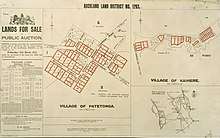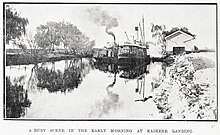Kaihere
Kaihere is a dispersed Waikato rural settlement on SH27, overlooking the Hauraki Plains. It has a school, hall, domain[1] a rest area[2] and is the starting point for the Hapuakohe Walkway.[1]
Kaihere | |
|---|---|
Village | |
 Kaihere | |
| Coordinates: 37°22′S 175°25′E | |
| Country | New Zealand |
| Region | Waikato region |
| District | Hauraki District |
| Elevation | 40 m (130 ft) |
| Population (2013 census) | |
| • Territorial | 135 |
| Time zone | UTC+12 (NZST) |
| • Summer (DST) | UTC+13 (NZDT) |
Demographics
Kaihere's meshblock (1069500 includes the school and most houses) had these census results -[3]
| Year | Population | Households | Average income | National average |
|---|---|---|---|---|
| 2001 | 114 | 39 | $32,500 | $18,500 |
| 2006 | 123 | 42 | $25,300 | $24,100 |
| 2013 | 135 | 51 | $31,300 | $27,900 |
Geology
The village lies on the edge of greywacke, of the Jurassic Manaia Hill Group, and the peat of the Hauraki graben. Much of the village is built on the Pliocene Puketoka formation between those.[4] That formation has boulders of andesite, quartz vein-stone, cryptocrystalline silica, and banded rhyolite, with cobbles of greywacke, in a poorly cemented bed of pumice silt. The Hauraki rift probably started about 3 million years ago.[5] Subsidence now is about 1.5 mm (0.059 in) a year.[6]

History
The early inhabitants largely used the wetlands for fishing. Ngāti Hako and Ngāti Pāoa lived in the area when early settlers arrived. The Musket Wars caused much disruption in the 1820s.[7]
Government gradually bought the wetlands, including Kaihere, until it controlled enough to enact the Hauraki Plains Act 1908.[8] In 1906 work started on a road to Ohinewai[9] and on cutting the bends in the Piako River below Kaihere Landing.[10] From 1908 stopbanks and drainage canals were built. By March 1915 38,994 acres (15,780 ha) had been sold to 294 farmers, mainly for dairying.[8]
Flax was milled at Kaihere from the 1890s to the 1940s.[8] Flax growing was set back by fires,[11] which were a problem as the peat dried out, following drainage.[12]
A 2018 plan will strengthen stopbanks and diversion ponds below Kaihere.[7]

Transport
A telemetry box on SH27, 1.4 km (0.87 mi) south of Kaihere[13] recorded average traffic up by 31% in the decade 2008 to 2017, from 3,965 to 5,182. 982 (19%) of those were heavy vehicles, mainly trucks.[14]
Until 1941 Northern Steamships linked Kaihere Landing with Auckland thrice weekly. Some of the landing is still visible.[15]
Education
Kaihere School is a 2-class rural primary school,[16][17] with a roll of 40 as of March 2020.[18][19]
The school has a play house, fort, native bush walk, playing field, netball court and a pool. It is an Enviroschool.[16]
War memorial pavilion
The 1929[20] Kaihere war memorial pavilion is listed as Category: A - Heritage Feature in Hauraki District Plan. It is a small timber gabled box cottage, in front of the 1917 Community Hall, with kauri bench seats under the veranda. It was moved from the Domain in Ohinewai Road[21] to the school in 2005,[22] was used by the Woman's Institute[21] and was intended as a library and sports pavilion. A new memorial was dedicated on 25 April 2006, with the moved First World War cairn, a new one for World War 2 and a settlers memorial wall.[22]
References
- "Kaihere Explore". www.haurakiplains.co.nz. Retrieved 4 January 2019.
- "Kaihere Lookout". kaihere-lookout.business.site. Retrieved 4 January 2019.
- "2013 Census map – QuickStats about a place". www.stats.govt.nz. Retrieved 27 October 2015.
- Edbrooke, S. W. (2005). "Geology of the Waikato area 1:250 000 geological map 4". Institute of Geological & Nuclear Sciences.
- Bruce Hayward, Hugh Grenfell (21 November 2010). "THE PUKETOKA FORMATION AND THE AGE OF THE HAURAKI GRABEN" (PDF).
- Jeremy Riffault, David Dempsey, Jennifer Eccles. "Ground motion simulations for Hauraki Rift earthquakes" (PDF).CS1 maint: multiple names: authors list (link)
- "The Hauraki Report Vol.2" (PDF). Waitangi Tribunal. 2006.
- "The Hauraki Report Vol.3" (PDF). Waitangi Tribunal. 2006.
- "APPROPRIATIONS CHARGEABLE ON THE PUBLIC WORKS FUND AND OTHER ACCOUNTS". paperspast.natlib.govt.nz. 1 January 1907. Retrieved 6 January 2019.
- "THE PIAKO SWAMP. OHINEMURI GAZETTE". paperspast.natlib.govt.nz. 9 February 1906. Retrieved 6 January 2019.
- "PEAT FIRES EXTEND. NEW ZEALAND HERALD". paperspast.natlib.govt.nz. 30 January 1932. Retrieved 6 January 2019.
- "HAURAKI PEAT LANDS. Recurring fire menace. AUCKLAND STAR". paperspast.natlib.govt.nz. 30 September 1932. Retrieved 6 January 2019.
- "1251 State Highway". Google Maps. Retrieved 5 January 2019.
- "NZTA 2017 National Telemetry Site Traffic Profile" (PDF).
- "668 Kaihere Rd". Google Maps. Retrieved 4 January 2019.
- "Kaihere School - About us". sites.google.com. Retrieved 4 January 2019.
- "Ministry of Education School Profile". educationcounts.govt.nz. Ministry of Education.
- "New Zealand Schools Directory". New Zealand Ministry of Education. Retrieved 26 April 2020.
- "Education Review Office Report". ero.govt.nz. Education Review Office.
- "Kaihere". nzhistory.govt.nz. Retrieved 4 January 2019.
- "Historic Heritage Inventory Kaihere Community Hall and Pavilion" (PDF). Hauraki District Plan.
- "Kaihere war memorials". nzhistory.govt.nz. Retrieved 4 January 2019.